|
|
|
Sort Order |
|
|
|
Items / Page
|
|
|
|
|
|
|
| Srl | Item |
| 1 |
ID:
060743
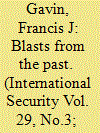

|
|
|
|
|
| Publication |
Winter 2004-05.
|
|
|
|
|
|
|
|
|
|
|
|
|
|
|
|
| 2 |
ID:
046275
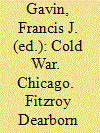

|
|
|
|
|
| Publication |
Chicago, Fitzroy Dearborn Publishers, 2001.
|
| Description |
2v (xv, 964p.)
|
| Contents |
vol 1 :1918-1963
vol 2 :1964-1992
|
| Standard Number |
1579583210
|
|
|
|
|
|
|
|
|
|
|
|
Copies: C:2/I:0,R:2,Q:0
Circulation
| Accession# | Call# | Current Location | Status | Policy | Location |
| 046207 | 940.55/GAV 046207 | Main | On Shelf | Reference books | |
| 046208 | 940.55/GAV 046208 | Main | On Shelf | Reference books | |
|
|
|
|
| 3 |
ID:
131342


|
|
|
|
|
| Publication |
2014.
|
| Summary/Abstract |
Most theories of war and peace in the modern world, whether they acknowledge it or not, emerge from three historical questions. Why did the First World War break out? Was Hitler's Germany - and its murderous campaign of domination and destruction - unique? And how do nuclear weapons affect international relations? Coming first and producing a seemingly inexhaustible inheritance that vexes geopolitics to this day (think Syria), no international relations scholar can avoid wrestling with the causes of what was once called the Great War.
|
|
|
|
|
|
|
|
|
|
|
|
|
|
|
|
| 4 |
ID:
151430
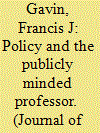

|
|
|
|
|
| Summary/Abstract |
In recent years, there has been a vigorous effort within the disciplines of political science and strategic studies to encourage scholars to become what is termed ‘policy relevant.’ These initiatives have supported an array of activities, including fellowships in government, training in opinion writing and media engagement, and funds to produce research that is perceived to be useful to decision-makers.11 Many of these activities have been generously supported by the Carnegie Corporation of New York. For a partial listing of some of these impressive programs, see Lena Andrews, Rebecca Friedman Lissner, Julia Macdonald, Jacquelyn Schneider and Rachel Whitlark, 6 May 2015, ‘Getting Involved in Policy: An Overworked Grad Student’s Guide,’ War on the Rocks, 28 Oct. 2016,
|
|
|
|
|
|
|
|
|
|
|
|
|
|
|
|
| 5 |
ID:
093023
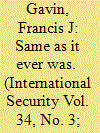

|
|
|
|
|
| Publication |
2009.
|
| Summary/Abstract |
A widely held and largely unchallenged view among many scholars and policymakers is that nuclear proliferation is the gravest threat facing the United States today, that it is more dangerous than ever, and that few meaningful lessons can be drawn from the nuclear history of a supposed simpler and more predictable period, the Cold War. This view, labeled "nuclear alarmism," is based on four myths about the history of the nuclear age. First, today's nuclear threats are new and more dangerous than those of the past. Second, unlike today, nuclear weapons stabilized international politics during the Cold War, when in fact the record was mixed. The third myth conflates the history of the nuclear arms race with the geopolitical and ideological competition between the Soviet Union and the United States, creating an oversimplified and misguided portrayal of the Cold War. The final myth is that the Cold War bipolar military rivalry was the only force driving nuclear proliferation. A better understanding of this history, and, in particular, of how and why the international community escaped calamity during a far more dangerous time against ruthless and powerful adversaries, can produce more effective U.S. policies than those proposed by the nuclear alarmists.
|
|
|
|
|
|
|
|
|
|
|
|
|
|
|
|
| 6 |
ID:
140915
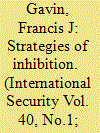

|
|
|
|
|
| Summary/Abstract |
The United States has gone to extraordinary lengths since the beginning of the nuclear age to inhibit—that is, to slow, halt, and reverse—the spread of nuclear weapons and, when unsuccessful, to mitigate the consequences. To accomplish this end, the United States has developed and implemented a wide range of tools, applied in a variety of combinations. These “strategies of inhibition” employ different policies rarely seen as connected to one another, from treaties and norms to alliances and security guarantees, to sanctions and preventive military action. The United States has applied these measures to friend and foe alike, often regardless of political orientation, economic system, or alliance status, to secure protection from nuclear attack and maintain freedom of action. Collectively, these linked strategies of inhibition have been an independent and driving feature of U.S. national security policy for more than seven decades, to an extent rarely documented or fully understood. The strategies of inhibition make sense of puzzles that neither containment nor openness strategies can explain, while providing critical insights into post–World War II history, theory, the causes of nuclear proliferation, and debates over the past, present, and future trajectory of U.S. grand strategy.
|
|
|
|
|
|
|
|
|
|
|
|
|
|
|
|
|
|
|
|
|